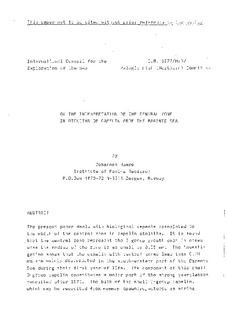| dc.contributor.author | Hamre, Johannes | |
| dc.date.accessioned | 2010-08-12T13:22:37Z | |
| dc.date.available | 2010-08-12T13:22:37Z | |
| dc.date.issued | 1977 | |
| dc.identifier.citation | This report is not to be quoted without prior consultation with the General Secretary. | en_US |
| dc.identifier.uri | http://hdl.handle.net/11250/102030 | |
| dc.description.abstract | The present paper deals with biological aspects associated to the width of the central zone in capelin otoliths. It is found that the central zone represent the 0-group growth even in cases when the radius of the zone is as small as 0.05 mm. The investigation shows that the capelin with central zones less than 0.20 mm are mainly distributed in the south-eastern part of the Barents Sea during their first year of life. The component of this small 0-group capelin constitutes a major part of the strong yearclasses recruited after 1970. The bulk of the small 0-group capelin, which may be recruited from summer spawners, matures as spring spawners at 5 years of age. whereas the recruits of the spring spawners, which is far the dominating spawning group, normally mature at 4 years. The increased strength of the small 0-group capelin has thus changed the age composition of the spawning stock and added a new cohort to the immature part of the population. This has to a large extent effected the Norwegian capelin fishery. | en_US |
| dc.language.iso | eng | en_US |
| dc.publisher | ICES | en_US |
| dc.relation.ispartofseries | ICES CM Documents;1977/H:37 | |
| dc.subject | capelin | en_US |
| dc.subject | lodde | en_US |
| dc.subject | age determination | en_US |
| dc.subject | aldersbestemmelse | en_US |
| dc.subject | Barents Sea | en_US |
| dc.subject | Barentshavet | en_US |
| dc.title | On the interpretation of the central zone in otoliths of capelin from the Barents Sea | en_US |
| dc.type | Working paper | en_US |
| dc.subject.nsi | VDP::Agriculture and fishery disciplines: 900::Fisheries science: 920::Resource biology: 921 | en_US |
| dc.source.pagenumber | 23 s. | en_US |
